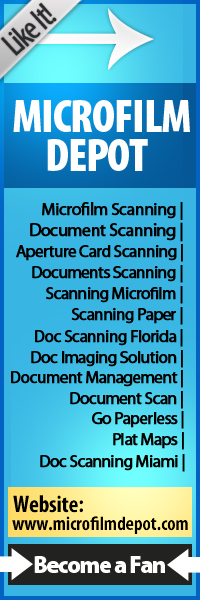The Benefits Of Using Microfilm Conversion Services
By Chris Ferrer
Analog data in the form of microfilm and microfiche is an effective means of archiving information. This storage method was once the standard for any organization with large amounts of paper documentation. As the world has gone digital many are looking for Microfilm Conversion Services in order to incorporate this data into existing archive databases. This allows for better access to the information and more efficient storage.
Call For A Free Test And Quote 954-806-7842
10200 State Road 84 #228 Davie Florida 33024
[email protected]
 Most large corporations, universities, government organizations and libraries have microform data archives. These days this data is rarely accessed because the process requires too much time and effort. In addition to this drawback, the need for a physical space for archiving is an expense that can be eliminated with digital conversion. Incorporating all archival information into a single system makes management simpler and more efficient.
Most large corporations, universities, government organizations and libraries have microform data archives. These days this data is rarely accessed because the process requires too much time and effort. In addition to this drawback, the need for a physical space for archiving is an expense that can be eliminated with digital conversion. Incorporating all archival information into a single system makes management simpler and more efficient.
To convert this information, most turn to an outsourcing service. These firms scan the information using specialized equipment and software. The process includes scanning, checking and auditing quality of the capture. Formats can be simple image files such as JPG or GIF, or using OCR (optical character recognition) files can be made into a searchable PDF. The files can also be indexed to ensure proper integration with existing digital retrieval systems. This allows the data to be accessed just as easily as an electronic file created today.
Scanning equipment can be purchased by an organization for the purpose of scanning microform data. It is however a major undertaking and an objective cost/benefit analysis generally favors outsourcing. The specialized equipment needed is costly, and there is also the labor and training expense to be considered. Typically between 7 and 10 million images can be scanned for the price of the equipment alone. Personnel costs, software, maintenance and other expenses make outsourcing the better course in most situations.
The other consideration is the amount of time it would take for in-house resources to complete the job. In most cases the time taken to purchase and set-up equipment, along with training and the actual work make outsourcing much quicker. These firms literally work 24/7 and are highly efficient at the task.
To find a firm to convert microform data, the quickest route is online. Firms are deployed around the globe and location does not have to be a barrier to using any service. That being said, it is important to do some research on any firm one is considering. In addition to cost, quality is the other main factor. Be sure to fully investigate the equipment, methods, process and experience of the firm. Poor quality output makes the whole process worthless.
Conversion costs are based on volume and format. One should look to obtain at least three estimates from quality firms. An RFP or other formal estimate request form should be used so each firm’s bids are based on the same information. This makes comparing the estimates much simpler. Be detailed in the requirements as changes during the process can be costly. One can also request samples of work to check output quality.
Any organization with significant amounts of microform data will benefit from digitization. Microfilm Conversion Services make the process quick and painless versus purchasing equipment for in-house use. Outsourcing is quicker, generally of higher quality and offers a much higher cost/benefit ratio.

